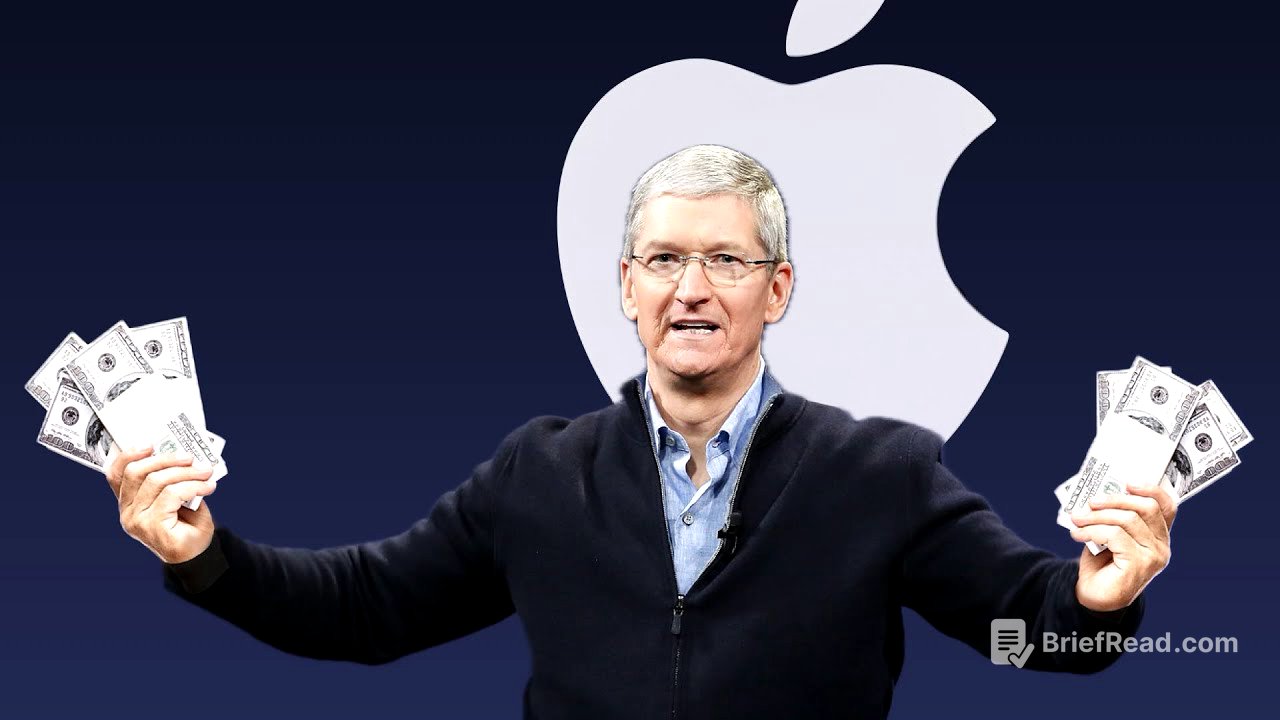TLDR;
This video explains how Apple generates its massive revenue and profits. It breaks down Apple's revenue streams, primarily focusing on hardware sales (like iPhone, Mac, and wearables) and the rapidly growing services sector (Apple Music, iCloud, Apple TV+, etc.). The video highlights Apple's strategic shift towards services for higher profit margins and increased customer retention through ecosystem lock-in and recurring subscriptions.
- Hardware sales, particularly the iPhone, constitute a significant portion of Apple's revenue.
- Apple's services sector has experienced rapid growth and boasts higher profit margins compared to hardware.
- Apple uses its ecosystem and subscription model to retain customers and generate recurring revenue.
Introduction: Apple's Revenue and Profit Sources [0:00]
Apple is the third most valuable company globally, with approximately $391 billion in revenue in fiscal year 2024. After subtracting costs like research and development, employee salaries, materials, and manufacturing, Apple's profit amounts to $93.7 billion, resulting in a 24% profit margin. The primary source of this revenue is hardware sales, including products like the Mac, iPod, iPhone, Apple Watch, and AirPods.
Hardware Sales: iPhone and Other Products [0:22]
The iPhone is Apple's most successful product, accounting for about 51% of the company's revenue. Other hardware products contribute as follows: Mac accounts for 8%, iPad for 7%, and wearables, home, and accessories (including Apple Watch, AirPods, and HomePod) for 9%. However, achieving profitability in hardware sales is a challenge for many consumer-facing companies.
The Challenge of Hardware Profitability [0:54]
Many companies struggle to achieve profitability with hardware, often selling products at cost or even at a loss. Examples include PlayStation and Xbox consoles, Amazon Kindle e-readers, and HP printers. These products are often sold at low prices to undercut competition and expand the user base. Profit is typically made when customers use the product, such as through game purchases for PlayStation, ebook purchases for Kindle, and ink cartridge purchases for HP printers.
Apple's Differentiation in the Consumer Market [2:28]
Tim Cook highlighted Steve Jobs' focus on consumer products, which was a unique approach at a time when many companies prioritized enterprise solutions. Unlike other computer hardware companies that offered similar products, Apple differentiated itself through striking designs, its own operating system optimized for its hardware, and company-owned stores providing technical support. This end-to-end experience allowed Apple to charge a premium.
Ecosystem and User Experience [5:58]
Today, technology products play a much larger role in our lives, and the seamless integration of devices is crucial. Apple's ecosystem, including devices like Apple TV, Apple Watch, iPhone, and MacBook, offers a smoother user experience. This has increased Apple's popularity and allowed the company to raise prices due to the higher value delivered to customers.
The Rise of Services [6:53]
In 2016, Apple recognized that hardware sales were slowing due to market saturation. To address this, Apple introduced new services in 2019 and 2020, including Apple News Plus, Apple Card, Apple Arcade, Apple TV Plus, and Apple Fitness Plus, joining existing services like Apple Music and iCloud Plus. Since the launch of Apple Music in 2015, Apple's services revenue grew from $20 billion a year to $96 billion by 2024, representing 25% of Apple's total revenue.
Profitability and Ecosystem Lock-In of Services [8:16]
Services offer higher profit margins compared to hardware, with a 74% profit margin for services versus a 35% margin for hardware. This is because the cost of providing services like Apple TV Plus does not scale in the same way as manufacturing iPhones. Additionally, services help lock customers into Apple's ecosystem. Services like Apple News Plus, Fitness Plus, Apple Pay, and Apple Arcade are exclusively available on Apple devices, making it less appealing for users to switch to other platforms.
Recurring Payments and Price Hikes [9:50]
Unlike one-time purchases from iTunes, modern services rely on recurring payments. Customers must maintain monthly subscriptions to access their music libraries and other services. This gives Apple significant power, as they can raise prices. For example, Apple TV Plus initially cost $4.99 a month but has since increased to $9.99. Similar price hikes have occurred with Apple Music, Apple Arcade, and Apple News Plus. Apple's services category has increased revenue and profit, kept users in the ecosystem, and generated recurring subscription fees.









